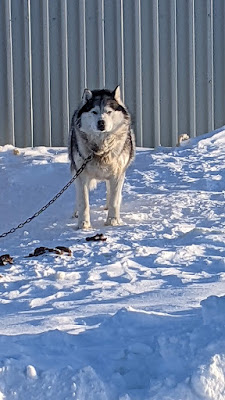
Day 11. A weather day at Cambridge Bay (CB). Today was a welcome down day and an opportunity to catch up with a few things. It also provided an opportunity to chat with the team working on the IVORI project and on the MOACC project. We were also given a fascinating tour of the CHARS facility by Dr. David Hik, the President and CEO of the CHARS facility.
First up, the CHARS building is an impressive federally funded building, about 10 years in the planning and making and a central part of Polar Knowledge Canada. It is a core part of Canada's Arctic research capacity and is home for scientists and researchers for short or longer periods of time. It has a staff complement located in CB but also in other parts of northern communities who help and assist in its operations.
The building itself is a LEED Silver designated building, no mean feat given the remoteness of the site. It facilitates research by providing infrastructure and logistical support for funded projects but it is also a hub of innovation for building design research and sustainable operations in northern communities. CHARS actively draws in novel thinking on sustainable cold environment building design and infrastructure. It also works with local communities in community and research activities as well as training and educational programs.
Spectacular indigenous artwork throughout the building
Entrance to main CHARS atrium
Main atrium
Building designed by and for people - LEED Silver status
The indigenous artwork in the main areas is fantastic
Science labs - large engineering projects
Well-stocked wet and dry labs
The gantry here can support all kinds of large objects such as animal carcasses (e.g. blue whale) for forensic analysis
Many lab spaces and communal commons for education and research discussions
Workshops and storage and more labs in the second building
One of the great snow projects that is ongoing this winter at CHARS is the IVORI project, the brainchild of Dr. Marie Dumont. The purpose is to "...build a microstructure-based model,
with a novel physics core, unifying the evolution of snow and firn..". This is very ambitious and requires a significant number of very detailed measurements of snow in different environments. Having worked on alpine snow, the team are working on tundra snow - quite different. In essence, the team extract structurally intact snow samples from the field, and place them under a CT scanner (x-ray computed tomography scanner, similar to one used in a hospital). This allows the team to observe the 3D structure of a snowpack in detail. For most people, snow is visualized as a six-sided snow dendrite (snowflake). But for us snow scientists, it is way more than that because snow changes during the season in response to water vapour fluxes through the pack that alter the morphological structure of the snow grains from dendrites, to rounded snow to cup-shaped hexagonal crystals - and many more in between. But a snowpack is way more than the individual snow grains because under gravity and thermal regimes, they form complex structures that control the microwave response - it is this response that we use to estimate how much water content is stored in a snow pack. But we need the models to help, and they need to be improved. So for this campaign we have high resolution measurements on the ground, like the ones collected by IVORI, and we have airborne microwave measurements from our radars in the Polar 5. Dan Kramer from U. Sherbrooke has been brilliant in measuring snow microstructure within snowpits excavated in the field, and was instrumental in installing our corner reflector in the field for the radar calibration. As a results of all this, and as mentioned in another post, the data sets that we are collecting are highly innovative, unique, and connect really well with researchers across the Arctic interested in snow and ice science. And we are not yet half way through our contribution to the campaign.

The X-Ray CT scanner with a sample ready to scan
Discussions between Lisa Bouvet (University of Grenoble / CNRS) and Julien Meloche (ECCC) about the snow microstructure that result from the scanned sample
At the end of the day, dinner was at the Kuugaq Café. Delicious Arctic Char Chowder :) The walk home afterwards was in -20C feeling like -30C with the wind - fairly cold here today, depending on who you talk with!!
View from CHARS to the town of CB
Sundown-ish
Part of the community of Cambridge Bay
Looking for sundogs...
...and finding a husky dog instead
And the final walk home for the evening.
Tomorrow: repeat survey of the MOACC IMA to tie up a few loose ends before we fly north to Resolute Bay.






















Comments
Post a Comment